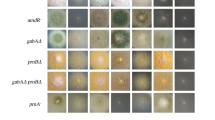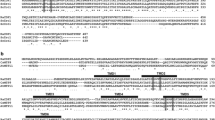Abstract
Fungi exposed to toxic substances including heavy metals, xenobiotics, or secondary metabolites formed by co-occurring plants or other microorganisms require a detoxification system provided by exporters of several classes of transmembrane proteins. In case of mycorrhiza, plant metabolites need to be exported at the plant interface, while the extraradical hyphae may prevent heavy metal uptake, thus acting as a biofilter to the host plant at high environmental concentrations. One major family of such transporter proteins is the multidrug and toxic compound extrusion (MATE) class, a member of which, Mte1, was studied in the ectomycorrhizal fungus Tricholoma vaccinum. Phylogenetic analyses placed the protein in a subgroup of basidiomycete MATE sequences. The gene mte1 was found to be induced during symbiotic interaction. It mediated detoxification of xenobiotics and metal ions such as Cu, Li, Al, and Ni, as well as secondary plant metabolites if heterologously expressed in Saccharomyces cerevisiae.







Similar content being viewed by others
References
Agerer R (2001) Exploration types of ectomycorrhizae: a proposal to classify ectomycorrhizal mycelial systems according to their patterns of differentiation and putative ecological importance. Mycorrhiza 11:107–114
Arita A, Zhou X, Ellen TP, Liu X, Bai J, Rooney JP, Kurtz A, Klein CB, Dai W, Begley TJ, Costa M (2009) A genome-wide deletion mutant screen identifies pathways affected by nickel sulfate in Saccharomyces cerevisiae. BMC Genomics 10:524
Asensio J, Ruiz-Argüeso T, Rodríguez-Navarro A (1976) Sensitivity of yeasts to lithium. Anton van Lee J M S 42:1–8
Asiimwe T, Krause K, Schlunk I, Kothe E (2012) Modulation of ethanol stress tolerance by aldehyde dehydrogenase in the mycorrhizal fungus Tricholoma vaccinum. Mycorrhiza 22:471–484
Burse A, Weingart H, Ullrich MS (2004) NorM, an Erwinia amylovora multidrug efflux pump involved in in vitro competition with other epiphytic bacteria. AEM 70:693–703
Cannon RD, Lamping E, Holmes AR, Niimi K, Baret PV, Keniya MV, Tanabe K, Niimi M, Goffeau A, Monk BC (2009) Efflux-mediated antifungal drug resistance. Clin Microbiol Rev 22:291–321
de Waard MA, Andrade AC, Hayashi K, Schoonbeek HJ, Stergiopoulos I, Zwiers LH (2006) Impact of fungal drug transporters on fungicide sensitivity, multidrug resistance and virulence. Pest Manag Sci 62:195–207
Del Sorbo G, Schoonbeek H, De Waard MA (2000) Fungal transporters involved in efflux of natural toxic compounds and fungicides. Fungal Genet Biol 30:1–15
Dichtl B, Stevens A, Tollervey D (1997) Lithium toxicity in yeast is due to the inhibition of RNA processing enzymes. EMBO J 16:7184–7195
Durrett TP, Gassmann W, Rogers EE (2007) The FRD3-mediated efflux of citrate into the root vasculature is necessary for efficient iron translocation. Plant Physiol 144:197–205
Fischer R, Timberlake WE (1995) Aspergillus nidulans apsA (anucleate primary sterigmata) encodes a coiled-coil protein required for nuclear positioning and completion of asexual development. J Cell Biol 128:485–498
Frohman MA (1993) Rapid amplification of complementary DNA ends for generation of full-length complementary DNAs: thermal RACE. Method Enzymol 218:340–356
Gherghel F, Krause K (2012) Role of mycorrhiza in re-forestation at heavy metal-contaminated sites. In: Kothe E and Varma A (eds) Bio-geo interactions in metal-contaminated soils, soil biology 31, Springer, Berlin, Heidelberg, pp 183–199
Gietz RD, Schiestl RH, Willems AR, Woods RA (1995) Studies on the transformation of intact yeast cells by the LiAc/SS-DNA/PEG procedure. Yeast 11:355–360
González-Guerrero M, Benabdellah K, Valderas A, Azcón-Aguilar C, Ferrol N (2010) GintABC1 encodes a putative ABC transporter of the MRP subfamily induced by Cu, Cd, and oxidative stress in Glomus intraradices. Mycorrhiza 20:137–146
Gorfer M, Persak H, Berger H, Brynda S, Bandian D, Strauss J (2009) Identification of heavy metal regulated genes from the root associated ascomycete Cadophora finlandica using a genomic microarray. Mycol Res 113:1377–1388
Hall JL (2001) Cellular mechanisms for heavy metal detoxification and tolerance. J Exp Bot 53:1–11
Huda MN, Morita Y, Kuroda T, Mizushima T, Tsuchiya T (2001) Na+-driven multidrug efflux pump VcmA from Vibrio cholerae non-O1, a non-halophilic bacterium. FEMS Microbiol Lett 203:235–239
Huelsenbeck JP, Ronquist F (2001) MRBAYES: Bayesian inference of phylogenetic trees. Bioinformatics 17:754–755
Hvorup RN, Winnen B, Chang AB, Jiang Y, Zhou XF, Saier MH Jr (2003) The multidrug/oligosaccharidyl-lipid/polysaccharide (MOP) exporter superfamily. Eur J Bioch 270:799–813
Kottke I, Guttenberger M, Hampp R, Oberwinkler F (1987) An in vitro method for establishing mycorrhiza on coniferous seedlings. Trees 1:191–194
Krause K, Kothe E (2006) Use of RNA fingerprinting to identify fungal genes specifically expressed during ectomycorrhizal interaction. J Basic Microb 46:387–399
Kuroda T, Tsuchiya T (2009) Multidrug efflux transporters in the MATE family. Biochim Biophys Acta 1794:763–768
Magalhaes JV (2010) How a microbial drug transporter became essential for crop cultivation on acid soils: aluminum tolerance conferred by the multidrug and toxic compound extrusion (MATE) family. Ann Bot 106:199–203
Mankel A, Kost G, Kothe E (1998) Re-evaluation of the phylogenetic relationship among species of the genus Tricholoma. Microbiol Res 153:377–388
Martin F, Kohler A, Duplessis S (2007) Living in harmony in the wood underground: ectomycorrhizal genomics. Curr Opin Plant Biol 10:204–210
Matsumoto T, Kanamoto T, Otsuka M, Omote H, Moriyama Y (2009) Role of glutamate residues in substrate recognition by human MATE1 polyspecific H+/organic cation exporter. Am J Physiol Cell Ph 294:C1074–1078
Morita Y, Kodama K, Shiota S, Mine T, Kataoka A, Mizushima T, Tsuchiya T (1998) NorM, a putative multidrug efflux protein, of Vibrio parahaemolyticus and its homolog in Escherichia coli. Antimicrob Agents Ch 42:1778–1782
Morita Y, Kataoka A, Shiota S, Mizushima T, Tsuchiya T (2000) NorM of Vibrio parahaemolyticus is an Na+-driven multidrug efflux pump. J Bacteriol 182:6694–6697
Morita M, Shitan N, Sawada K, van Montagu MC, Inzé D, Rischer H, Goossens A, Oksman-Caldentey KM, Moriyama Y, Yazaki K (2009) Vacuolar transport of nicotine is mediated by a multidrug and toxic compound extrusion (MATE) transporter in Nicotiana tabacum. Proc Natl Acad Sci U S A 106:2447–2452
Moriyama Y, Hiasa M, Matsumoto T, Omote H (2008) Multidrug and toxic compound extrusion (MATE)-type proteins as anchor transporters for the excretion of metabolic waste products and xenobiotics. Xenobiotica 38:1107–1118
Nehls U, Göhringer F, Wittulsky S, Dietz S (2010) Fungal carbohydrate support in the ectomycorrhizal symbiosis: a review. Plant Biol 12:292–301
Omote H, Hiasa M, Matsumoto T, Otsuka M, Moriyama Y (2006) The MATE proteins as fundamental transporters of metabolic and xenobiotic organic cations. Trends Pharmacol Sci 27:587–593
Paumi CM, Chuk M, Snider J, Stagljar I, Michaelis S (2009) ABC transporters in Saccharomyces cerevisiae and their interactors: new technology advances the biology of the ABCC (MRP) subfamily. Microbiol Mol Biol R 73:577–593
Penninckx M (2000) A short review on the role of glutathione in the response of yeasts to nutritional, environmental, and oxidative stresses. Enzyme Microb Technol 26:737–742
Perrone GG, Grant CM, Daws IW (2005) Genetic and environmental factors influencing glutathione homeostasis in Saccharomyces cerevisiae. Mol Biol Cell 16:218–230
Pócsi I, Prade RA, Penninckx MJ (2004) Glutathione, altruistic metabolite in fungi. Adv Microb Physiol 49:1–76
Rieger S (1995) Veränderungen des Monoterpenspektrums in verletzten Fichtenwurzeln und ihre potentielle Bedeutung für die Resistenz gegenüber Heterobasidion annosum. Eur J Forest Pathol 25:367–380
Rozman D, Komel R (1994) Isolation of genomic DNA from filamentous fungi with high glucan level. Bio Tech 16:382
Sambrook J, Fritsch EF, Maniatis T (1989) Molecular cloning—a laboratory manual. Cold Spring Harbor Laboratory Press, Cold Spring Harbor
Shaefer B (1995) Revolution in rapid amplification of cDNA ends: new strategies for polymerase chain reaction cloning of full-length cDNA ends. Anal Biochem 227:255–273
Shiomi N, Fukuda H, Fukuda Y, Murata K, Kimura A (1991) Nucleotide sequence and characterization of a gene conferring resistance to ethionine in yeast Saccharomyces cerevisiae. J Ferment Bioeng 71:211–215
Smith SE, Read DJ (2008) Mycorrhizal symbiosis. Academic, New York
Zhao J, Dixon RA (2009) MATE transporters facilitate vacuolar uptake of epicatechin 3′-O-glucoside for proanthocyanidin biosynthesis in Medicago truncatula and Arabidopsis. Plant Cell 21:2323–2340
Acknowledgments
The research was supported by the German Research Foundation with Graduate School 214. We want to thank Prof. H. Deising from the Martin Luther University Halle-Wittenberg for discussion and supply with fungicide substances and Dr. C Hertweck and Dr. Michael Ramm from the Hans Knöll Institute, Jena, for the supply with secondary metabolites.
Author information
Authors and Affiliations
Corresponding author
Additional information
Responsible editor: Philippe Garrigues
Electronic supplementary material
Below is the link to the electronic supplementary material.
ESM 1
(DOC 10553 kb)
Rights and permissions
About this article
Cite this article
Schlunk, I., Krause, K., Wirth, S. et al. A transporter for abiotic stress and plant metabolite resistance in the ectomycorrhizal fungus Tricholoma vaccinum . Environ Sci Pollut Res 22, 19384–19393 (2015). https://doi.org/10.1007/s11356-014-4044-8
Received:
Accepted:
Published:
Issue Date:
DOI: https://doi.org/10.1007/s11356-014-4044-8




